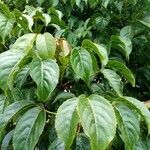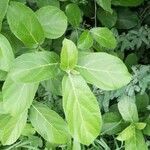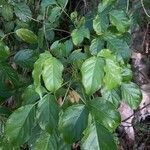Trees, to 15[–40] m; buttresses often present; heartwood, bark, and sap red. Leaves: stipules subulate, 5–10 mm; petiole 3–22 cm; petiolules present, that of terminal leaflet to 6.5 cm; leaflets usually elliptic, rarely obovate, 4–15 × 2–10 cm, base cuneate, margins with basal teeth sometimes glandular, surfaces glabrous. Inflorescences erect in flower, pendent, to 32 cm, in fruit. Pedicels: staminate to 2.6 mm; pistillate to 11 mm in fruit, abscission zone near midpoint. Staminate flowers red in bud, yellow at anthesis, 2.5 mm diam.; sepals becoming reflexed, ovate, concave, 1.2 mm, nearly as wide; filaments 0.5 mm; anthers yellow, 1 mm. Pistillate flowers 2–3 × 1.5–2 mm; sepals ovate, 2–4 × 1 mm; staminodes to 0.5 mm; ovary green; styles 0.7 mm; stigmas erect in flower, spreading or reflexed in fruit, whitish, linear, to 5 mm. Drupes dark red to brown, 8–10 × 7–10 mm. Seeds oblong or curved, 4 × 3 × 3 mm. 2n = 196.
A large stocky tree. It grows up to 40 m tall. It can range from 5 to 30 m tall. The trunk is 1 m across, and straight. The trunk is covered with dull brown scaly bark. It is 2 cm thick and peels off in irregular flakes. The bark gives a red exudate when cut. The branches are numerous and form a dense rounded crown. The leaves are alternate, and with 3 leaflets. The leaf has a long leaf stalk. The leaflets are oval and tapering towards the tip. The edges of the leaflets are toothed. The leaves are dark green and glossy on the upper surface and light green and smooth underneath. The flowering branch has many branches. The individual flowers are small numerous and yellow-green. Trees have male and female flowers on separate plants. The fruit are rounded and fleshy. They have 3 to 4 cells and are reddish brown. They are 3 mm across. They contain 6 small seeds.
Tree to 35 m high. Stipules lanceolate, c. 2 mm long. Leaves: petiole 35–75 mm long; lamina up to 110 mm long and wide; petiolules 2–35 mm long; leaflets elliptic to ovate, 13–90 mm long, 25–70 mm wide, base cuneate to rounded, tip acute to acuminate; lateral veins 6–8 per side of midrib. Inflorescence up to 170 mm long. Male flowers c. 1 mm long and 1.5 mm diam. Female flowers 4–5 mm long, 3–4 mm diam. Fruits 6–14 mm long, 6–15 mm diam.





